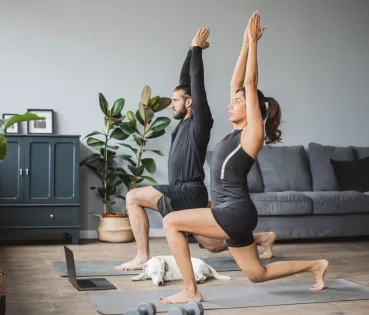
Six simple exercises for looking after your back
Exercise routines are useful to develop muscle strength, resistance or elasticity and to prevent and treat chronic back pain. Doctors from the Kovacs Back Unit at the Hospital HLA Universitario Moncloa, explain to us, step by step, some of the exercises included on a routine that is specially indicated for people with thoracic-lumbar pain, the most frequent pain amongst the population.
1. Raising opposite arm and leg
Lie face down with your arms out in front of you. From this posture, raise your right arm, your head and your left leg, slightly bent backwards. At the same time, keep the other arm and leg lying flat on the floor. After a fraction of a second, lower the raised limbs and repeat the movement until completing half of the series. After this, change sides to complete the series.
Don’t forget… bend the leg you are lifting slightly, lift your head each time and do one side first and then the other.
2. Standing pelvic tilt
Put your buttocks and shoulders against the wall with the lower back area forming an arc. From this position, make a movement consisting of making the lower back area touch the wall. To do this, tilt the pelvis (contract the stomach) pulling your buttocks upwards and forwards. Once the spine is resting up against the wall, hold the position for around 5 seconds. Then return to the starting position and repeat the movement until finishing the series.
It’s normal… to lift your heels and support yourself on the tips of your toes or to bend your knees slightly.
3. Lying down pelvic tilt
Lie face up with your knees bent and your feet flat on the floor. Most of your back must be touching the floor, except for the lower back area, which must be arched. The exercise consists of making the spine touch the floor. To do this you must tilt your pelvis. Hold the position with the lower back area against the floor for around 5 seconds. Then return to the starting position and repeat the movement until finishing the series.
Remember… Contracting the abdominal muscles is what should “drag” the buttocks upwards.
4. Transverse abdominal exercise
Get down onto your hands and knees, with your knees and hands flat on the floor. Your back should be straight, horizontal, without being arched up or down and the abdomen muscles should be relaxed, in such a way that your tummy ‘drops down’. Without arching your back, contract your abdominal muscles to pull your tummy in. Hold this position for 4 or 5 seconds and relax. Repeat the movement until completing the series.
Don’t forget… Pull your tummy in fast and intensely and keep it as close to your back as possible during the contraction.
5. Knee embrace
Lie face up, with your knees bent and your feet flat on the floor. Your arms should be stretched out alongside your body. From this position, bend your neck forwards as if trying to look at your navel, raise your knees towards your chest and hold them with the hand on the same side or embrace them with both hands. Hold the position for a few seconds. Press your knees slightly against your chest (if it is not painful to do so). Then slowly return to the starting position and remain there for a few seconds.
Ideal for… relaxing the lower back muscles.
6. The cat
Get down on your hands and knees, with your knees and hands flat on the floor, you arms vertical and your back straight, horizontal. From this posture, curve your back as far as possible, arching forwards and curving upwards and sit back onto your heels. Return to the starting position and repeat the movement until completing the series.
Ideal for… relaxing the muscles closest to the vertebrae.
Take into account
- Suitability. Anyone can do this routine, as it is made up of exercises designed for people who have a very low physical level or who suffer from chronic pain. However, if an exercise triggers pain or increases the pain being suffered, stop it and consult your doctor or physiotherapist.
- Frequency. We can start to carry out the first sessions twice a week, not on consecutive days and progressively, as our physical fitness improves, increase these sessions to four or five days a week.
- Repetitions. It is recommended to do each exercise in the routine for a minimum of 2 series of 10 repetitions each, resting between each series for a period that is less than the amount of time taken to do the series.
- What do I do if I have any pain? You should not do anything that triggers the pain or increases its intensity, but until you reach this level you should do all that you can. In acute crises (acute pain from 0 to 15 days), exercise is contraindicated. People with chronic pain (which they have had for more than 3 months), can do exercise except when they are suffering from a very acute crisis, when they should take relative rest, avoiding doing anything that increases the pain.










